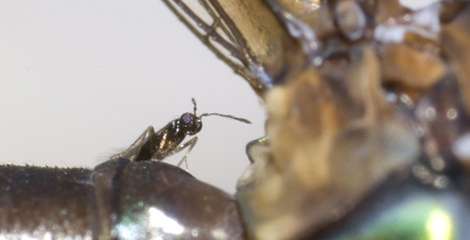Newly discovered wasp is a parasitic piggyback

A previously unknown species of parasitoid wasp that rides on the back of damselflies before laying eggs inside their eggs, has been discovered in Taiwan by a team of scientists, including an entomologist from the Natural History Museum.
Hydrophylita emporos is only 1.2mm long and is the first species of its subgenus, Hydrophylita (Lutzimicron), that has been found in Asia, and the first observed transporting itself on another organism. The genus contains just four other described species, all from South America.
The tiny wasp was identified by Yuan Tung Shih, from the National Taiwan University, and Andrew Polaszek, from the Museum.
It was discovered when Yuan spotted the minute wasps riding on the back of a damselfly while collecting insects near Taipei and sent Polaszek a video and some specimens to identify.
Eggs for dinner
Adult H. emporos females wait at the base of the damselfly's abdomen and then walk down it into the water when the damselfly lays its eggs, and lay their own eggs inside them.
When the wasp larvae hatch they feed on the damselfly's eggs until they are ready to pupate.
Polaszek, an expert on parasitoid wasps, says, 'When I examined the wasps I was amazed as they belonged to a group known previously only from South America – the species from Taiwan was clearly new to science.
'Although the hosts of this genus were known to be damselfly eggs, the hitch-hiking behaviour – known as phoresy – had not been observed previously in the genus.'
Fittingly, the name emporos means passenger.
Rare males
Male H. emporos seem to be extremely rare, around one in every 125 wasps, and may remain underwater for most of their life.
It is not currently know how the wasps manage to avoid being swept away by water currents or, apparently, breathe for up to 24 hours underwater. Yuan and Polaszek are carrying out further studies to reveal the morphological adaptations that allow this remarkable insect to live a semi-aquatic lifestyle.
The scientific description of H. emporos is published in the journal PLoS ONE.
More information: PLoS ONE 8(7): e69331. doi:10.1371/journal.pone.0069331
Journal information: PLoS ONE
Provided by Natural History Museum





















